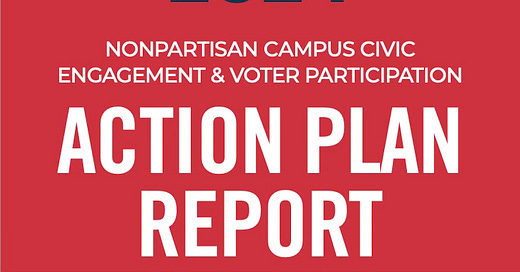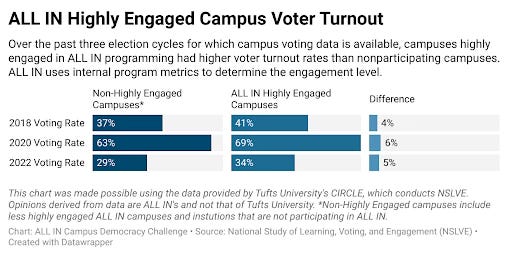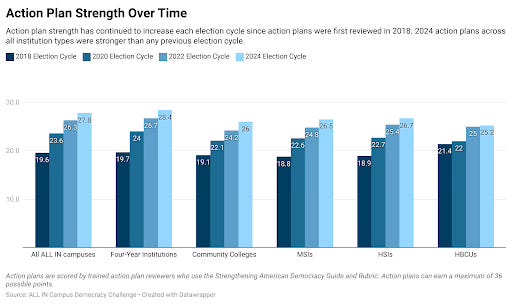Campuses wrote better, more strategic nonpartisan action plans in the 2024 election cycle.
A dive into the 2024 ALL IN Action Plan Report
The 2024 ALL IN Action Plan Report, released last month, sends a clear message to the movement for 100% student voter participation: Creating campus coalitions and developing and implementing nonpartisan civic engagement action plans leads to higher campus civic engagement and voter turnout.
ALL IN’s analysis of data from the 2022 National Study of Learning, Voting, and Engagement shows campuses consistently highly engaged in nonpartisan civic engagement saw campus turnout rates 5 percentage points higher than those that were less engaged. This is consistent with 2018 turnout that was 4 percentage points higher and 2020 turnout that was 6 percentage points higher than less engaged campuses.
A record 632 campuses submitted 2024 action plans to ALL IN, action planning retention for participating campuses improved, and ALL IN Communities of Practice show strong results for increasing campus engagement, especially among community colleges and Hispanic-Serving Institutions.
Action plans have gotten stronger over the past four election cycles.
In 2018 ALL IN, in partnership with the Students Learn Students Vote Coalition, the American Democracy Project, the Fair Election Center’s Campus Vote Project, Democracy Works, NASPA, Student PIRGs, and the Andrew Goodman Foundation, developed the Strengthening American Democracy Guide (SADG) and Rubric to help guide and assess campuses in their creation of nonpartisan democratic engagement action plans. As the volume of action plans have grown over the past four election cycles, so too has their quality, with average SADG rubric scores growing from 19.6 out of a possible 36 in 2018 to 27.8 in 2024.
Importantly, while there are clear benefits for campuses that repeat the action planning process across multiple election cycles, campus retention alone does not explain the impressive rise in action plan scores on the SADG rubric. Among campuses filling out an action plan for the first time ever, average SADG scores have risen from 17.0 in 2018 to 24.3 in 2024.
This can likely be attributed to ALL IN’s enhanced action planning support, which includes an updated and improved SADG, training webinars, and pre-populated and custom action plan templates based on the SADG. In fact, in the last election cycle, 83% of ALL IN campuses that had not submitted an action plan in the previous election cycle reported using an ALL IN-provided template in 2024. And among campuses that had previously submitted an action plan, 74% used ALL IN’s confidential feedback report based on the SADG rubric.
The improvement in action plan quality is all the more impressive given the fact that in the 2024 cycle campuses took, on average, nearly a year less time between joining ALL IN and submitting their first action plan than during the 2018 election cycle. Thanks to improved templates, better communication, and training through the SLSV Coalition’s Action Plan Working Group, average submission time for newly engaged campuses fell from 17 months in 2018 to just 6 months last year.
Campus coalitions are becoming more inclusive
Research from the P3 Lab at Johns Hopkins SNF Agora Institute on Strategic Capacity, defined as “the ability to take a challenge and build power in reckoning with it, as opposed to having a setback,” identified working in diverse, complex coalitions as a key element in developing this important trait. As Dr. Kristine Lu wrote in this Substack last year, “The collaborations they foster allow organizations to diversify their knowledge by absorbing that of others – even when mutual learning is not an explicit goal of organizations involved in a collaboration. For example, research shows that knowledge about tactics can diffuse between organizations simply from co-engaging in actions.”
ALL IN’s 632 participating campuses appear to be building this principle into their action plans, with the majority of participating four-year universities, community colleges, Minority-Serving Institutions, and Historically Black Colleges & Universities each including student affairs staff, students and student organizations, faculty, academic affairs staff, and nonprofit organizations in their nonpartisan student voting coalitions. Significant portions of each type of institution also have incorporated representatives from the office of the president or chancellor, local election officials, and residence life personnel.
Acknowledging the reality of turnover
Another key aspect of strategic capacity is building clear lines of accountability, including succession plans should one person or group become unable to fulfill the responsibilities assigned to them. This is crucial on college campuses, where turnover of students, staff, and faculty is a frequent reality.
Since it began assessing action plans for this aspect in 2020, ALL IN has seen a near-tripling of explicit leadership succession plans, which were included by 15% of campuses in 2020 and 44% of campuses in 2024. Continued growth in this area should prove especially beneficial to future nonpartisan civic engagement efforts, as they ensure responsibilities and institutional knowledge don’t leave an institution entirely if one or a handful of key leaders depart.
The upshot
As campuses approach the 2025 and 2026 elections while navigating an unpredictable era for higher education and U.S. democracy, growing and deepening nonpartisan civic engagement action planning could prove crucial to growing the strategic capacity needed for student vote leaders to successfully adapt to current and future challenges. The 2024 ALL IN Action Plan Report offers encouraging evidence that more and more campuses are doing just that.
The report also demonstrates that campuses seeking to grow student voter turnout have a strong existing roadmap available to them, which they can follow by devoting more people and resources to engage in nonpartisan action planning and civic engagement processes that have proven beneficial. Moving forward, ALL IN will look to build on this positive impact with the release of new and updated resources that increase support and reduce barriers for campuses as they begin and/or deepen their action planning work.






